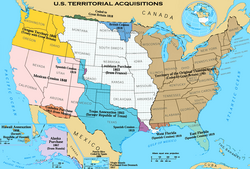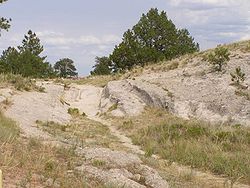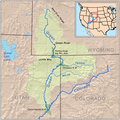Oregon Trail
People traveled along the Oregon Trail during the 19th century in order to settle new parts of the United States of America. The Trail was used from 1841 to the 1880s, but fewer people used it after the Transcontinental Railroad was opened in 1869.
 Map of the Oregon Trail | |
| Operation | |
|---|---|
| Created by | Fur traders in the 1830s |
| Years used | 1841-1880s[1] |
| Location | Illinois, Iowa, Missouri, Kansas, Nebraska, Wyoming, Idaho, Oregon |
| Length | 2,170 miles (3,500 kilometres)[1] |
| Travelers | |
| Total number | 400,000 (estimated)[1] |
| Deaths | 16,000[2] – 40,000[3] |
| Now a National Historic Trail of the National Park Service | |
Before this railroad connected the East and West Coasts, if people wanted to cross the country, they had to migrate west along the Oregon Trail in wagons. This dangerous journey was about 2,170 miles (3,500 km) long and usually took four to six months.[4]
People went to Oregon for many reasons. Most wanted a new life; others wanted land or simply thought that Oregon would be a better place to live.[4]
Between 300,000 and 500,000[4] people used the Oregon Trail. This was an important migration in American history. There were many dangers on the Trail, and up to 40,000[5] travelers died along the way.
Location
The Oregon Trail started in Missouri, near the area where Kansas City, Missouri is today. It ended in the Willamette Valley in Oregon. It passes through eight modern-day states:
Preparing to travel
Travelers did not go on the Oregon Trail alone. Instead, they formed groups so they could help and protect each other. Often, relatives or people from the same town traveled together. They elected leaders and hired guides that knew the Trail. The groups that did best on the Trail wrote constitutions or rules that they could use to settle disagreements or problems on the Trail.[5]
Supplies
Animals
People who traveled the Oregon Trail could use three types of animals to pull their wagons: oxen, mules, or horses. Most people used oxen. They were less expensive than horses and mules, and also less stubborn than mules.[6]pp. 79–80
They could eat grass along the Trail, unlike horses, who needed grains when they were working. Oxen were easy to train, and they usually traveled at a steady pace of 2 miles per hour, even in mud and snow.[6]pp. 79–80
Food
It was very important for travelers to carry enough food and water for the trip. However, this was expensive. To feed four people for six months, food would cost about $150 - over $4,500 in today's dollars.[6]p. 274
Travelers often brought along a lot of dried meat and "bread stuff" (like flour, crackers, and hardtack). Boiling water was difficult on the Trail, so cooking was not always possible. Some travelers also brought other foods, like rice, peas, dried beans, or dried fruit.[7]
Along the Trail, travelers could fish and hunt for food. Bison, antelope, and deer were the best animals to hunt for food. Travelers also ate berries that grew along the Trail, partly to help prevent scurvy.[7]
Wagons
Most travelers used covered wagons to travel the Trail. There were a few different styles. One common type, called the "Independence-style" wagon, was usually about 11 feet long, four feet wide, and two feet deep. Pieces of wood held up a cover, made of something like dried ox skin, that rose about five feet above the bottom of the wagon.[5]
Dangers
The many dangers along the Oregon Trail included disease, bad weather, drowning during river crossings, and attacks by Native Americans.
Diseases
Disease was the most common cause of death on the Trail. While travelers usually brought some medicines with them, they usually were not very helpful.[3]
Cholera
Cholera was the most common illness and cause of death on the Trail.[3] Often, its symptoms would be so bad that travelers would die within 12 hours of getting sick.[3] During an epidemic in 1849-1855, up to 3% of all travelers on the trail may have died from cholera.
The disease spread partly because there was no sanitation along the trail. For example, travelers liked to camp along the Platte River in Colorado so they could easily get fresh water. However, as thousands of travelers used the same campsites over and over again, sewage from travelers with cholera got into the Platte River.[8] After this, any traveler that drank water from the Platte River, or made food with that water, could get cholera.
Other diseases
Other common diseases on the Trail included:[3]
- Dysentery and other illnesses that caused diarrhea. The travelers treated these diseases with castor oil.
- "Mountain fever", which may have been Rocky Mountain spotted fever, typhus, typhoid fever, and/or scarlet fever. The travelers used quinine water to treat these illnesses.
- Measles
- Food poisoning
- Scurvy, which travelers tried to prevent by eating berries along the Trail and drinking citric acid. Still, because they ate mostly meat and bread along the Trail, many travelers did not get enough vitamin C. Some had scurvy when they arrived at the end of the Trail; others died from it before finishing the journey.
- Smallpox
- Pneumonia
The travelers used turpentine (a poison), vinegar, and whiskey to treat headaches, muscle pain, and coughs.[3]
Deaths
It is difficult to know how many people died along the Oregon Trail. Many travelers buried their dead in unmarked graves and disguised the graves so that animals and grave robbers would not dig them up. For example, they would bury people right in the middle of a trail and then have their oxen run over the graves.
Because of this, historians can only estimate the total number of people who died along the Oregon Trail.[2] One estimate says 16,000[2] people died; another says 40,000[6] did.
Overall, historian John Unruh estimates that 4 percent of the Oregon Trail travelers died: 16,000 out of 400,000 total travelers.[2] However, the United States National Park Service says:
The Oregon Trail is this nation’s longest graveyard. Nearly one in ten [travelers] who set off on the trail did not survive.[3]
Unruh estimates
Unruh estimates the number of people who died from these dangers along the Trail:[2]
- 6,000 to 12,000 from diseases other than scurvy (the United States National Park Service says this number may be as high as 30,000[3])
- 300 to 500 from scurvy
- 3,000 to 4,500 from Native American attacks
- 300 to 500 from freezing to death
- 200 to 500 from being accidentally run over by wagons
- 200 to 500 from drowning while trying to cross rivers
- 200 to 500 from accidentally being shot (for example, in hunting accidents)
- 200 to 500 from other causes, including murder, being hit by lightning, dying during childbirth, stampedes, snake bites, flash floods, being hit by falling trees, and being kicked by animals
Life on the Trail
Travel
A usual day on the Trail started very early, just before dawn. Nobody actually rode in the wagons unless they were sick or very young. The ride was too bumpy, too dusty, and added too much work for the oxen. Instead, people walked beside their wagons.
Usually, groups traveled almost all day, except for an hour around noon for lunch. Then they kept moving until just before sunset, when they would stop to set up a campsite.
Most groups traveled about 15 miles per day, though on the best days they could move 20 miles a day. Since oxen moved at about 2 miles per hour, this meant a day's travel could last up to ten hours.[1][5][9]
Children
About 40,000 of the travelers were children.[9] Unless they were babies, they walked alongside the wagons and worked just like adults. Their jobs included herding animals, driving wagons, washing dishes, helping with meals, watching younger children, and collecting firewood and "buffalo chips" (dry buffalo manure used to start fires).[9]
At nighttime
At night, the group would move the wagons into a circle ("circle the wagons") and put their animals inside the circle. This kept them from wandering away, being stolen, or being killed. In dry weather people slept outside; if it was wet, people slept under their wagons.
Native Americans
Many travelers were terrified of attacks from Native Americans. However, most Native Americans left the travelers alone, or even helped them by trading with them and helping them cross rivers in canoes.[3][9] When Native Americans did attack travelers, the stories were told over and over again, which may have made attacks seem more common than they actually were.
Travelers who did reach Oregon looked back on the Trail with different feelings. One man named Loren Hastings said in 1847:
I look back upon the long, dangerous and precarious emigrant road with a degree of romance and pleasure; but to others it is the graveyard of their friends.[5]
Computer game
In the 1970s, three student teachers in Minnesota made an educational computer game based on the Oregon Trail. The goal of the game was to successfully travel the trail from Independence, Missouri to Oregon City, Oregon. Dangers along the way included river crossings, illnesses, sick oxen, and hunger.
The game became extremely popular. Over the next two decades, new versions of the game were made that added more options and included better graphics. The second version included zombies and oxen. The goal was to survive as long as possible before dying.
Oregon Trail Media
U.S. territorial acquisitions–portions of each territory were granted statehood since the 18th century.
The first Fort Laramie as it looked prior to 1840. Painting from memory by Alfred Jacob Miller
Trail ruts near Guernsey, Wyoming
The exploration of the West by Jedediah Smith
Map of the Green River watershed
Related pages
References
- ↑ 1.0 1.1 1.2 1.3 "Basic Facts about the Oregon Trail". National Historic Oregon Trail Interpretive Center. United States Department of the Interior Bureau of Land Management. Archived from the original on March 4, 2016. Retrieved February 11, 2016.
- ↑ 2.0 2.1 2.2 2.3 2.4 Unruh, John David (1993). The Plains Across: The Overland Emigrants and the Trans-Mississippi West, 1840–1860. University of Illinois Press. pp. 408–410, 516. ISBN 978-0-252-06360-2.
- ↑ 3.0 3.1 3.2 3.3 3.4 3.5 3.6 3.7 3.8 "Death and Danger Along the Trails" (PDF). NPS.gov. United States National Park Service. Archived from the original (PDF) on November 6, 2015. Retrieved February 11, 2016.
- ↑ 4.0 4.1 4.2 National Historic Oregon Trail Interpretive Center. "Basic Facts About the Oregon Trail" (PDF). United States Department of the Interior: Bureau of Land Management.
- ↑ 5.0 5.1 5.2 5.3 5.4 "Life and Death on the Oregon Trail". octa-trails.org. Oregon-California Trails Association. Retrieved February 11, 2016.
- ↑ 6.0 6.1 6.2 6.3 Dary, David (2004). The Oregon Trail: An American Saga. Knopt. ISBN 0-375-41399-5.
- ↑ 7.0 7.1 McLynn, Frank (2002). Wagons West: The Epic Story of America's Overland Trails. Random House. pp. 103–104. ISBN 978-0802140630.
- ↑ Mattes, Merrill J. (1987). The Great Platte River Road: The Covered Wagon Mainline Via Fort Kearny to Fort Laramie. University of Nebraska Press. p. 85. ISBN 9780803281530.
- ↑ 9.0 9.1 9.2 9.3 "Kids on the Trail". National Historic Oregon Trail Interpretive Center. United States Department of the Interior Bureau of Land Management. Archived from the original on February 5, 2016. Retrieved February 11, 2016.











